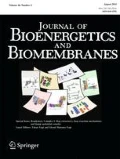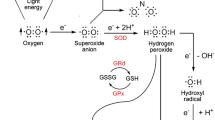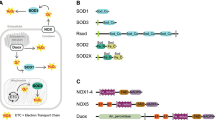Abstract
The expression of morphine by plants, invertebrate, and vertebrate cells and organ systems, strongly indicates a high level of evolutionary conservation of morphine and related morphinan alkaloids as required for life. The prototype catecholamine, dopamine, serves as an essential chemical intermediate in morphine biosynthesis, both in plants and animals. We surmise that, before the emergence of specialized plant and animal cells/organ systems, primordial multi-potential cell types required selective mechanisms to limit their responsiveness to environmental cues. Accordingly, cellular systems that emerged with the potential for recruitment of the free radical gas nitric oxide (NO) as a multi-faceted autocrine/paracrine signaling molecule, were provided with extremely positive evolutionary advantages. Endogenous morphinergic signaling, in concert with NO-coupled signaling systems, has evolved as an autocrine/paracrine regulator of metabolic homeostasis, energy metabolism, mitochondrial respiration and energy production. Basic physiological processes involving morphinergic/NO-coupled regulation of mitochondrial function, with special emphasis on the cardiovascular system, are critical to all organismic survival. Key to this concept may be the phenomenon of mitochondrial enslavement in eukaryotic evolution via endogenous morphine.






Similar content being viewed by others
References
Andersen S, Baar C, Fladvad T, Laugsand EA, Skorpen F (2013) The N-terminally truncated micro3 and micro3-like opioid receptors are transcribed from a novel promoter upstream of exon 2 in the human OPRM1 gene. PLoS One 8:e71024. doi:10.1371/journal.pone.0071024
Bates TE, Loesch A, Burnstock G, Clark JB (1996) Mitochondrial nitric oxide synthase: a ubiquitous regulator of oxidative phosphorylation? Biochem Biophys Res Commun 218:40–44
Boettcher C, Fellermeier M, Boettcher C, Drager B, Zenk MH (2005) How human neuroblastoma cells make morphine. Proc Natl Acad Sci USA 102:8495–8500
Borutaite V, Morkuniene R, Arandarcikaite O, Jekabsone A, Barauskaite J, Brown GC (2009) Nitric oxide protects the heart from ischemia-induced apoptosis and mitochondrial damage via protein kinase G mediated blockage of permeability transition and cytochrome c release. J Biomed Sci 16:70. doi:10.1186/1423-0127-16-70
Brown GC, Cooper CE (1994) Nanomolar concentrations of nitric oxide reversibly inhibit synaptosomal respiration by competing with oxygen at cytochrome oxidase. FEBS Lett 356:295–298
Cadet P, Mantione KJ, Stefano GB (2003) Molecular identification and functional expression of mu3, a novel alternatively spliced variant of the human mu opiate receptor gene. J Immunol 170:5118–5123
Cadet P, Mantione KJ, Zhu W, Kream RM, Sheehan M, Stefano GB (2007) A functionally coupled mu3-like opiate receptor/nitric oxide regulatory pathway in human multi-lineage progenitor cells. J Immunol 179:5839–5844
Casares FM, McElroy A, Mantione KJ, Baggerman G, Zhu W, Stefano GB (2005) The American lobster, homarus americanus, contains morphine that is coupled to nitric oxide release in its nervous and immune tissues: evidence for neurotransmitter and hormonal signaling. Neuroendocrinol Lett 26:89–97
Cavalier-Smith T (2006) Origin of mitochondria by intracellular enslavement of a photosynthetic purple bacterium. Proc Biol Sci 273:1943–1952. doi:10.1098/rspb.2006.3531
Chang WL, Lee SS, Su MJ (2005) Attenuation of post-ischemia reperfusion injury by thaliporphine and morphine in rat hearts. J Biomed Sci 12:611–619. doi:10.1007/s11373-005-7401-2
Chistiakov VV, Gegenava GP (1976) Mechanism of opiate of oxidative phosphorylation in mitochondria. Biokhimiia 41:1272–1278
Chistiakov VV, Gegenava GP (1980) Mechanism of opiate-induced permeability of mitochondrial membranes for potassium ions. Biokhimiia 45:492–497
Cohen MV, Yang XM, Liu GS, Heusch G, Downey JM (2001) Acetylcholine, bradykinin, opioids, and phenylephrine, but not adenosine, trigger preconditioning by generating free radicals and opening mitochondrial K(ATP) channels. Circ Res 89:273–278
di Jeso F, Giorgini D, Truscello A (1982) In vitro effect of morphine on oxidative phosphorylation in mitochondria on non-neural cells. C R Seances Soc Biol Fil 176:151–153
di Jeso B, Truscello A, di Jeso F (1984) Morphine receptors in rat liver mitochondrial membranes. C R Seances Soc Biol Fil 178:52–55
DiStefano A, Paulesu L (1994) Inhibitory effect of melatonin on production of IFN gamma or TNF alpha in peripheral blood mononuclear cells of some blood donors. J Pineal Res 17:164–169
Fimiani C et al. (1999) Morphine and anandamide stimulate intracellular calcium transients in human arterial endothelial endothelial cells: coupling to nitric oxide release. Cell Signal 11:189–193
Finocchietto PV et al. (2009) Mitochondrial nitric oxide synthase: a masterpiece of metabolic adaptation, cell growth, transformation, and death. Exp Biol Med (Maywood) 234:1020–1028. doi:10.3181/0902-MR-81
Fricchione G et al. (2008) Identification of endogenous morphine and a mu3-like opiate alkaloid receptor in human brain tissue taken from a patient with intractable complex partial epilepsy. Med Sci Monit 14:CS45–CS49
Gateau-Roesch O, Argaud L, Ovize M (2006) Mitochondrial permeability transition pore and postconditioning. Cardiovasc Res 70:264–273. doi:10.1016/j.cardiores.2006.02.024
Gegenava GP, Chistiakov VV (1975) Effect of morphine in vitro on the oxidative phosphorylation in rat liver mitochondria. Biull Eksp Biol Med 80:77–79
Giuffre A et al. (2002) Nitric oxide reacts with the single-electron reduced active site of cytochrome c oxidase. J Biol Chem 277:22402–22406. doi:10.1074/jbc.M201514200
Giulivi C, Kato K, Cooper CE (2006) Nitric oxide regulation of mitochondrial oxygen consumption I: cellular physiology. Am J Physiol Cell Physiol 291:C1225–C1231
Jang Y, Xi J, Wang H, Mueller RA, Norfleet EA, Xu Z (2008) Postconditioning prevents reperfusion injury by activating delta-opioid receptors. Anesthesiology 108:243–250. doi:10.1097/01.anes.0000299437.93898.4a
Kanai AJ et al. (2001) Identification of a neuronal nitric oxide synthase in isolated cardiac mitochondria using electrochemical detection. Proc Natl Acad Sci U S A 98:14126–14131. doi:10.1073/pnas.241380298
Kato K, Giulivi C (2006) Critical overview of mitochondrial nitric-oxide synthase. Front Biosci 11:2725–2738
Kotturi MF, Hunt SV, Jefferies WA (2006) Roles of CRAC and Cav-like channels in T cells: more than one gatekeeper? Trends Pharmacol Sci 27:360–367
Kream RM, Stefano GB (2006) De novo biosynthesis of morphine in animal cells: an evidence-based model. Med Sci Monit 12:RA207–RA219
Kream RM, Stefano GB (2009) Endogenous morphine and nitric oxide coupled regulation of mitochondrial processes. Med Sci Monit 15:RA263–RA268
Kream RM, Stefano GB (2010) Interactive effects of endogenous morphine, nitric oxide, and ethanol on mitochondrial processes. Arc Med Sci 6:658–662
Kream RM, Sheehan M, Cadet P, Mantione KJ, Zhu W, Casares FM, Stefano GB (2007) Persistence of evolutionary memory: primordial six-transmembrane helical domain mu opiate receptors selectively linked to endogenous morphine signaling. Med Sci Monit 13:SC5–SC6
Kream RM, Mantione KJ, Sheehan M, Stefano GB (2009) Morphine's chemical messenger status in animals. Act Nerv Super Rediviva 51:153–161
Liscombe DK, Facchini PJ (2008) Evolutionary and cellular webs in benzylisoquinoline alkaloid biosynthesis. Curr Opin Biotechnol 19:173–180. doi:10.1016/j.copbio.2008.02.012
Liscombe DK, MacLeod BP, Loukanina N, Nandi OI, Facchini PJ (2005) Evidence for the monophyletic evolution of benzylisoquinoline alkaloid biosynthesis in angiosperms. Phytochemistry 66:1374–1393. doi:10.1016/j.phytochem.2005.04.029
Lishmanov YB et al. (2004) Role of opiate receptors and ATP-dependent potassium channels of mitochondria in the formation of myocardial adaptive resistance to the arrhythmogenic effect of ischemia and reperfusion. Izvestiya RANseriya Biologicheskaya 6:720–727
Ludwig LM, Patel HH, Gross GJ, Kersten JR, Pagel PS, Warltier DC (2003) Morphine enhances pharmacological preconditioning by isoflurane: role of mitochondrial K(ATP) channels and opioid receptors. Anesthesiology 98:705–711
Mantione KJ et al. (2008) Endogenous morphine signaling via nitric oxide regulates the expression of CYP2D6 and COMT: autocrine/paracrine feedback inhibition. Addict Biol 13:118–123
Maslov LN, Lishmanov YB, Solenkova NV, Gross GJ, Stefano GB, Tam SW (2003) Activation of peripheral delta opioid receptors eliminates cardiac electrical instability in a rat model of post-infarction cardiosclerosis via mitochondrial ATP-dependent K(+) channels. Life Sci 73:947–952
McPherson BC, Yao Z (2001) Morphine mimics preconditioning via free radical signals and mitochondrial K(ATP) channels in myocytes. Circulation 103:290–295
Nieto-Fernandez FE, Mattocks DW, Cavani F, Salzet M, Stefano GB (1999) Morphine coupling to invertebrate immunocyte nitric oxide release is dependent on intracellular calcium transients. Comp Biochem Physiol 123:295–299
Obame FN, Plin-Mercier C, Assaly R, Zini R, Dubois-Rande JL, Berdeaux A, Morin D (2008) Cardioprotective effect of morphine and a blocker of glycogen synthase kinase 3 beta, SB216763 [3-(2,4-dichlorophenyl)-4(1-methyl-1 H-indol-3-yl)-1 H-pyrrole-2,5-dione], via inhibition of the mitochondrial permeability transition pore. J Pharmacol Exp Ther 326:252–258. doi:10.1124/jpet.108.138008
Peart JN, Gross GJ (2003) Adenosine and opioid receptor-mediated cardioprotection in the rat: evidence for cross-talk between receptors. Am J Physiol Heart Circ Physiol 285:H81–H89. doi:10.1152/ajpheart.00985.2002
Prime TA et al. (2009) A mitochondria-targeted S-nitrosothiol modulates respiration, nitrosates thiols, and protects against ischemia-reperfusion injury. Proc Natl Acad Sci U S A 106:10764–10769. doi:10.1073/pnas.0903250106
Sarti P, Giuffre A, Barone MC, Forte E, Mastronicola D, Brunori M (2003) Nitric oxide and cytochrome oxidase: reaction mechanisms from the enzyme to the cell. Free Radic Biol Med 34:509–520
Sheehan M (2009) Opiate processes in poultry. Arc Med Sci 5:626–636
Stefano GB (1989) Role of opioid neuropeptides in immunoregulation. Prog Neurobiol 33:149–159
Stefano GB (1998) Autoimmunovascular regulation: morphine and anandamide stimulated nitric oxide release. J Neuroimmunol 83:70–76
Stefano GB, Kream RM (2007) Endogenous morphine synthetic pathway preceded and gave rise to catecholamine synthesis in evolution (review). Int J Mol Med 20:837–841
Stefano GB, Kream R (2008) Endogenous opiates, opioids, and immune function: evolutionary brokerage of defensive behaviors. Semin Cancer Biol 18:190–198
Stefano GB, Kream RM (2010) Dopamine, morphine, and nitric oxide: an evolutionary signaling triad. CNS Neurosci Ther 16:e124–e137. doi:10.1111/j.1755-5949.2009.00114.x
Stefano GB, Scharrer B (1994) Endogenous morphine and related opiates, a new class of chemical messengers. Adv Neuroimmunol 4:57–68
Stefano GB et al. (1993) Opiate-like substances in an invertebrate, an opiate receptor on invertebrate and human immunocytes, and a role in immunosuppression. Proc Natl Acad Sci U S A 90:11099–11103
Stefano GB, Kushnerik V, Rodriquez M, Bilfinger TV (1994) Inhibitory effect of morphine on granulocyte stimulation of tumor necrosis factor and substance P. Int J Immunopharmacol 16:329
Stefano GB, Hartman A, Bilfinger TV, Magazine HI, Liu Y, Casares F, Goligorsky MS (1995a) Presence of the mu3 opiate receptor in endothelial cells. coupling to nitric oxide production and vasodilation. J Biol Chem 270:30290–30293
Stefano GB, Hartman A, Bilfinger TV, Magazine HI, Liu Y, Casares F, Goligorsky MS (1995b) Presence of the mu3 opiate receptor in endothelial cells: coupling to nitric oxide production and vasodilation. J Biol Chem 270:30290–30293
Stefano GB et al. (1996) Opioid and opiate immunoregulatory processes. Crit Revin Immunol 16:109–144
Stefano GB, Goumon Y, Bilfinger TV, Welters I, Cadet P (2000a) Basal nitric oxide limits immune, nervous and cardiovascular excitation: human endothelia express a mu opiate receptor. Prog Neurobiol 60:513–530
Stefano GB et al. (2000b) Endogenous morphine. Trends Neurosci 9:436–442
Stefano GB, Neenan K, Cadet P, Magazine HI, Bilfinger TV (2001) Ischemic preconditioning - an opiate constitutive nitric oxide molecular hypothesis. Med Sci Monit 7:1357–1375
Stefano GB et al. (2008) Endogenous morphine/nitric oxide-coupled regulation of cellular physiology and gene expression: implications for cancer biology. Semin Cancer Biol 18:199–210
Stefano GB, Kim C, Mantione KJ, Casares FM, Kream RM (2012) Targeting mitochondrial biogenesis for promoting health. Med Sci Monit 18:SC1–SC3
Venkatesan S, Petrovic A, Locati M, Kim YO, Weissman D, Murphy PM (2001) A membrane-proximal basic domain and cysteine cluster in the C-terminal tail of CCR5 constitute a bipartite motif critical for cell surface expression. J Biol Chem 276:40133–40145
Zhu W, Cadet P, Baggerman G, Mantione KJ, Stefano GB (2005a) Human white blood cells synthesize morphine: CYP2D6 modulation. J Immunol 175:7357–7362
Zhu W et al. (2005b) Tyrosine and tyramine increase endogenous ganglionic morphine and dopamine levels in vitro and in vivo: CYP2D6 and tyrosine hydroxylase modulation demonstrates a dopamine coupling. Med Sci Monit 11:BR397–BR404
Zuurbier CJ, Smeele KM, Eerbeek O (2009) Mitochondrial hexokinase and cardioprotection of the intact heart. J Bioenerg Biomembr 41:181–185. doi:10.1007/s10863-009-9209-7
Author information
Authors and Affiliations
Corresponding author
Rights and permissions
About this article
Cite this article
Stefano, G.B., Mantione, K.J., Capellan, L. et al. Morphine stimulates nitric oxide release in human mitochondria. J Bioenerg Biomembr 47, 409–417 (2015). https://doi.org/10.1007/s10863-015-9626-8
Received:
Accepted:
Published:
Issue Date:
DOI: https://doi.org/10.1007/s10863-015-9626-8




